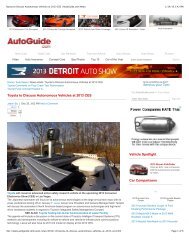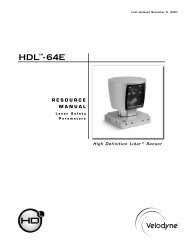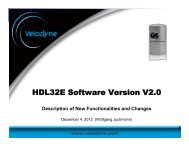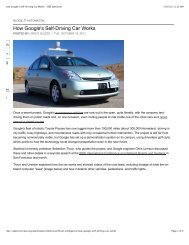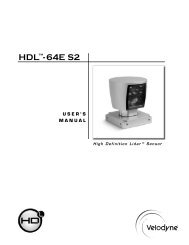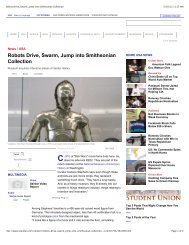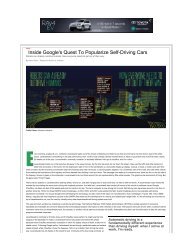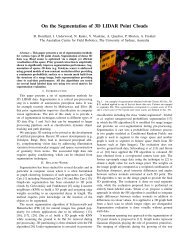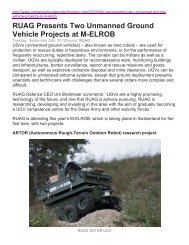Driverless Vehicles Make Inroads in Military - Velodyne Lidar
Driverless Vehicles Make Inroads in Military - Velodyne Lidar
Driverless Vehicles Make Inroads in Military - Velodyne Lidar
You also want an ePaper? Increase the reach of your titles
YUMPU automatically turns print PDFs into web optimized ePapers that Google loves.
Q & A<br />
for the <strong>in</strong>frastructure to communicate to the wrongway<br />
vehicles and pull them to the shoulder until law<br />
enforcement can arrive. We could save hundreds of<br />
lives each year.<br />
Q: Infrastructure changes are often costly. Do<br />
you see the cost benefit as worthwhile versus<br />
implement<strong>in</strong>g changes only to a vehicle’s onboard<br />
technology<br />
A: I th<strong>in</strong>k it’s premature to willy-nilly <strong>in</strong>vest <strong>in</strong> driverless<br />
vehicle technology <strong>in</strong>frastructure. Frankly, most of<br />
it hasn’t been <strong>in</strong>vented yet. The challenge that we face as<br />
highway authorities is, at some po<strong>in</strong>t, as the driverless vehicle<br />
technology gets more sophisticated, we’re go<strong>in</strong>g to<br />
need to have some pretty fundamental<br />
discussions about<br />
whether we want to <strong>in</strong>crease<br />
roadway capacity through <strong>in</strong>vest<strong>in</strong>g<br />
<strong>in</strong> electronic platforms<br />
versus pour<strong>in</strong>g more concrete<br />
and expand<strong>in</strong>g our physical<br />
facilities.<br />
I th<strong>in</strong>k that what makes sense<br />
from a cost-benefit analysis<br />
now is for cities and highway<br />
authorities to partner up with<br />
the auto manufacturers; other<br />
<strong>in</strong>novators, such as Google <strong>in</strong><br />
this area; and local research<br />
<strong>in</strong>stitutions to figure out exactly<br />
what does a highway<br />
of the future look like. That<br />
future highway is probably<br />
based on wireless communications and <strong>in</strong>volves a fiberoptic<br />
backbone, both of which we have already <strong>in</strong> some<br />
form. There’s probably a generation of sensors that allow<br />
communications between vehicles and <strong>in</strong>frastructure.<br />
Aga<strong>in</strong>, a lot of it rema<strong>in</strong>s to be <strong>in</strong>vented, so what we<br />
need to do now is <strong>in</strong>vest <strong>in</strong> that research and work together<br />
on some vision<strong>in</strong>g and hopefully some solutions.<br />
Q: What are examples of simple <strong>in</strong>frastructure<br />
solutions cities could implement that better<br />
enable driverless cars<br />
A: Here’s someth<strong>in</strong>g that we’re already th<strong>in</strong>k<strong>in</strong>g about:<br />
Do you pa<strong>in</strong>t your roadways differently so that sensor-equipped<br />
vehicles can read the roadway more effectively<br />
Exist<strong>in</strong>g vehicles now are com<strong>in</strong>g equipped<br />
with lane-chang<strong>in</strong>g technologies, where the vehicle<br />
alerts you if you’re steer<strong>in</strong>g out of your lane. Could<br />
‘We’re <strong>in</strong> the equivalent of the early<br />
1900s. They didn’t wait back then<br />
for the <strong>in</strong>terstate highway system to<br />
deploy the Model T. They put the<br />
Model T out there on the dirt roads,<br />
and when it ra<strong>in</strong>ed the horse did<br />
better. Yet, it was the release of new<br />
vehicular technology that prompted<br />
the development of paved roads<br />
and ultimately the <strong>in</strong>terstates. A similar<br />
process is happen<strong>in</strong>g now.’<br />
we enhance that technology just through better strip<strong>in</strong>g<br />
Are there ways to make vehicles, guardrails and<br />
other highway features visually more resonant to lidar,<br />
<strong>in</strong>frared and photo sensors One of the th<strong>in</strong>gs we can<br />
and should be do<strong>in</strong>g right now is consider<strong>in</strong>g how do<br />
we remake the look of our roadways us<strong>in</strong>g exist<strong>in</strong>g elements<br />
so that driverless and connected vehicles can<br />
operate more effectively and safely.<br />
Beyond that, we’re all wait<strong>in</strong>g on the federal government<br />
to move on the 5.9-gigahertz wireless spectrum.<br />
If we f<strong>in</strong>ally get that as an established standard, we can<br />
talk about develop<strong>in</strong>g sensors that broadcast road condition<br />
<strong>in</strong>formation and upcom<strong>in</strong>g traffic <strong>in</strong>formation and<br />
stoplight technology that alerts vehicles to another vehicle<br />
that’s go<strong>in</strong>g to run a light.<br />
Those k<strong>in</strong>d <strong>in</strong>vestments could<br />
be good ones <strong>in</strong> the relative<br />
near term.<br />
Q: How can cities better<br />
prepare themselves for<br />
driverless cars that could<br />
soon be com<strong>in</strong>g to their<br />
roads<br />
A: At this po<strong>in</strong>t what’s needed<br />
is for folks to identify the<br />
upsides and downsides of<br />
the technology and use local,<br />
regional, state and federal<br />
resources to try to figure out<br />
ways to facilitate the deployment<br />
of autonomous and<br />
connected vehicle technology.<br />
We’re <strong>in</strong> the equivalent of the early 1900s. They didn’t<br />
wait back then for the <strong>in</strong>terstate highway system to deploy<br />
the Model T. They put the Model T out there on<br />
the dirt roads, and when it ra<strong>in</strong>ed the horse did better.<br />
Yet, it was the release of new vehicular technology that<br />
prompted the development of paved roads and ultimately<br />
the <strong>in</strong>terstates. A similar process is happen<strong>in</strong>g<br />
now. Google and other <strong>in</strong>novators are go<strong>in</strong>g to be putt<strong>in</strong>g<br />
the driverless vehicles out there on “dumb” 20th<br />
century <strong>in</strong>frastructure. It’s go<strong>in</strong>g to take a while for the<br />
<strong>in</strong>frastructure to catch up with “smart” cars, just as it<br />
took a while for the <strong>in</strong>terstate highway system to catch<br />
up with the descendents of the Model T. That’s where I<br />
see us go<strong>in</strong>g. The key question is what’s the <strong>in</strong>frastructure<br />
platform that will make the onboard driverless/<br />
connected vehicle technology work more effectively<br />
and more safely<br />
MISSION CRITICAL • May 2013 15






